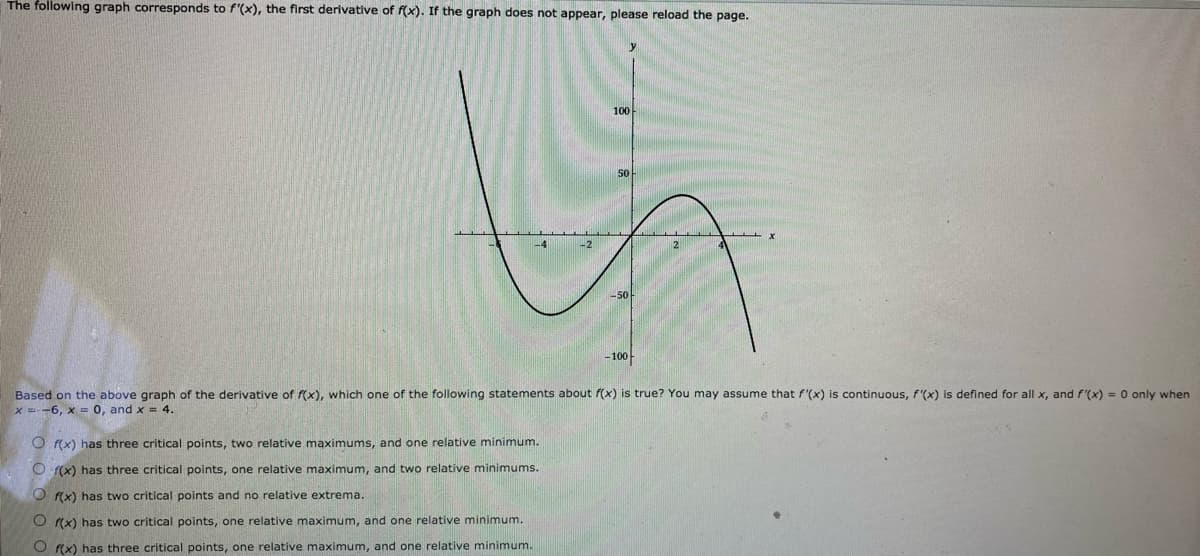graph does not appear, please reload the page. 100 50 -S0 -100 Based on the above graph of the derivative of (x), which one of the following statements about f(x) is true? You may assume that f'(x) is continuous, f'(x) is defined for all x, and f'(x) = 0 only whe X -6, x= 0, and x = 4. O (x) has three critical points, two relative maximums, and one relative minimum. O (x) has three critical points, one relative maximum, and two relative minimums. f(x) has two critical points and no relative extrema. O (x) has two critical points, one relative maximum, and one relative minimum.
graph does not appear, please reload the page. 100 50 -S0 -100 Based on the above graph of the derivative of (x), which one of the following statements about f(x) is true? You may assume that f'(x) is continuous, f'(x) is defined for all x, and f'(x) = 0 only whe X -6, x= 0, and x = 4. O (x) has three critical points, two relative maximums, and one relative minimum. O (x) has three critical points, one relative maximum, and two relative minimums. f(x) has two critical points and no relative extrema. O (x) has two critical points, one relative maximum, and one relative minimum.
Trigonometry (MindTap Course List)
10th Edition
ISBN:9781337278461
Author:Ron Larson
Publisher:Ron Larson
ChapterP: Prerequisites
SectionP.6: Analyzing Graphs Of Functions
Problem 6ECP: Find the average rates of change of f(x)=x2+2x (a) from x1=3 to x2=2 and (b) from x1=2 to x2=0.
Related questions
Topic Video
Question

Transcribed Image Text:The following graph corresponds to f'(x), the first derivative of f(x). If the graph does not appear, please reload the page.
100
-50
-100-
Based on the above graph of the derivative of f(x), which one of the following statements about f(x) is true? You may assume that f'(x) is continuous, f'(x) is defined for all x, and f'(x) = 0 only when
X =-6, x = 0, and x = 4.
O f(x) has three critical points, two relative maximums, and one relative minimum.
O f(x) has three critical points, one relative maximum, and two relative minimums.
O (x) has two critical points and no relative extrema.
O r(x) has two critical points, one relative maximum, and one relative minimum.
O r(x) has three critical points, one relative maximum, and one relative minimum.
Expert Solution
This question has been solved!
Explore an expertly crafted, step-by-step solution for a thorough understanding of key concepts.
Step by step
Solved in 3 steps

Knowledge Booster
Learn more about
Need a deep-dive on the concept behind this application? Look no further. Learn more about this topic, calculus and related others by exploring similar questions and additional content below.Recommended textbooks for you

Trigonometry (MindTap Course List)
Trigonometry
ISBN:
9781337278461
Author:
Ron Larson
Publisher:
Cengage Learning

Trigonometry (MindTap Course List)
Trigonometry
ISBN:
9781337278461
Author:
Ron Larson
Publisher:
Cengage Learning